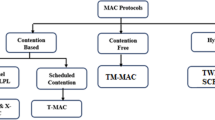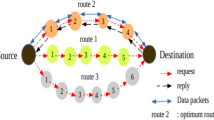Abstract
Energy efficiency is an important issue for mobile computers since they must rely on their batteries. We present an architecture for wireless ATM and a novel MAC protocol that achieves a good energy efficiency of the wireless interface of the mobile and provides QoS support for diverse traffic types. The scheduler of the base station is responsible for providing the required QoS to connections on the wireless link and to minimize the amount of energy spent by the mobile. The main principles used are to avoid unsuccessful actions, to minimize the number of transitions, and to synchronize the mobile and the base station. In the protocol the actions of the mobile are minimized. The base station with plenty of energy performs actions in courtesy of the mobile. We have paid much attention in reducing the cost for a mobile of just being connected. The protocol is able to provide near-optimal energy efficiency (i.e., energy is spent for the actual transfer only) for a mobile within the constraints of the QoS of all connections in a cell, and only requires a small overhead.
Similar content being viewed by others
References
A. Abnous and J. Rabaey, Ultra-low-power domain-specific multimedia processors, in: Proc. of the IEEE VLSI Signal Processing Workshop, San Francisco (October 1996).
T.-W. Chen, Krzyzanowski P., M.R. Lyu, C. Sreenan and ? Trotter, Renegotiable Quality of Service-a new scheme for fault tolerance in wireless networks, in: Proc. of FTCS'97 (1997).
T.-W. Chen et al., Comparison of MAC protocols for wireless local networks based on battery power consumption, in: IEEE Infocom'98, San Francisco, USA (March 1998) pp. 150-157.
A. Chockalingam and M. Zorzi, Energy consumption performance of a class of access protocols for mobile data networks, in: VTC'98, Ottawa, Canada (May 1998).
S. Dorward, R. Pike, D. Presotto, D. Ritchie, H. Trickey and P. Winterbottom, Inferno, in: Proc. of COMPCON Spring'97, 42nd IEEE Internat. Computer Conf. (1997) (more information on URL: http://www.lucent.com/inferno).
D.A. Eckhardt and P. Steenkiste, Improving wireless LAN performance via adaptive local error control, in: 6th IEEE Internat. Conf. on Network Protocols (ICNP'98), Austin (October 1998).
D. Eckhardt and P. Steenkiste, A trace-based evaluation of adaptive error correction for a wireless local area network, Mobile Networks and Applications (MONET), special issue on Adaptive Mobile Networking and Computing 4(4) (1999) 273–287.
M. Elaoud and P. Ramanathan, Adaptive use of error-correcting codes for real-time communication in wireless networks, in: Proc. of IEEE Infocom'98 (March 1998) pp. 548-555.
P.J.M. Havinga, Energy efficiency of error correction on wireless systems, in: IEEE Wireless Communications and Networking Conference (1999).
P.J.M. Havinga and G.J.M. Smit, Minimizing energy consumption for wireless computers in Moby Dick, in: Proc. of IEEE Internat. Conf. on Personal Wireless Communication ICPWC'97 (December 1997).
P.J.M. Havinga and G.J.M. Smit, The Pocket Companion's Architecture, in: Proc. of Euromicro Summer School on Mobile Computing' 98, Oulu, Finland (August 1998) pp. 25-34.
IEEE, Wireless LAN medium access control (MAC) and physical layer (PHY) Spec. P802.1VD5, Draft Standard IEEE 802.11 (May 1996).
ETSI, High performance radio local area network (HIPERLAN), Draft Standard ETS 300 652 (March 1996).
G.R.J. Linnenbank, A power dissipation comparison of the R-TDMA and the Slotted-Aloha wireless MAC protocols, Moby Dick technical report, http://www.huygens.org/~linnenba/ papers/MobyDick/energy.html (1997).
P. Lettieri and M.B. Srivastava, Adaptive frame length control for improving wireless link throughput, range, and energy efficiency, in: IEEE Infocom'98, San Francisco, USA (March 1998) pp. 307-314.
B. Mangione-Smith, Low power communications protocols: Paging and beyond, in: Low Power Symposium (1995); http://www. icsl.ucla.edu/~billms/Publications/ pagingprotocols.pdf.
B. Mangione-Smith et al., A low power architecture for wireless multimedia systems: Lessons learned from building a power hog, in: Proc. of ISLPED 1996, Monterey, CA, USA (1996) pp. 23-28.
R. van Nobelen, N. Seshadri, J. Whitehead and S. Timiri, An adaptive radio link protocol with enhanced data rates for GSM evolution, IEEE Personal Communications (February 1999) pp. 54-64.
Radiometrix, Low power UHF data transceiver module, http://www.radiometrix.co.uk/products/bimsheet.htm
C. Schuler, Optimization and adaptation of error-control algorithms for wireless ATM, International Journal of Wireless Information Networks 5(2) (1998).
K.M. Sivalingam, M.B. Srivastava and P. Agrawal, Low power link and access protocols for wireless multimedia networks, in: Proc. of IEEE Vehicular Technology Conference, Phoenix, AZ (May 1997) pp. 1331-1335.
G.J.M. Smit et al., Overview of the Moby Dick project, in: Proc. of Euromicro Summer School on Mobile Computing'98, Oulu, Finland (August 1998) pp. 159-168.
M. Stemm et al., Reducing power consumption of network interfaces for hand-held devices, in: Proc. of MoMuc-3 (1996).
WaveLAN/PCMCIA network adapter card, http://www.wavelan.com/support/libpdf/fs-pcm.pdf
H. Woesner, J. Ebert, M. Schläger and A. Wolisz, Power-saving mechanisms in emerging standards for wireless LANs: The MAC level perspective, IEEE Personal Communications 5(3) (1998).
Author information
Authors and Affiliations
Rights and permissions
About this article
Cite this article
Havinga, P.J., Smit, G.J. & Bos, M. Energy‐efficient wireless ATM design. Mobile Networks and Applications 5, 147–155 (2000). https://doi.org/10.1023/A:1019100410491
Issue Date:
DOI: https://doi.org/10.1023/A:1019100410491




